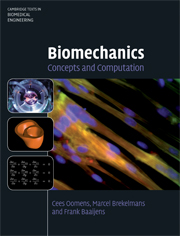Book contents
- Frontmatter
- Contents
- About the cover
- Preface
- 1 Vector calculus
- 2 The concepts of force and moment
- 3 Static equilibrium
- 4 The mechanical behaviour of fibres
- 5 Fibres: time-dependent behaviour
- 6 Analysis of a one-dimensional continuous elastic medium
- 7 Biological materials and continuum mechanics
- 8 Stress in three-dimensional continuous media
- 9 Motion: the time as an extra dimension
- 10 Deformation and rotation, deformation rate and spin
- 11 Local balance of mass, momentum and energy
- 12 Constitutive modelling of solids and fluids
- 13 Solution strategies for solid and fluid mechanics problems
- 14 Solution of the one-dimensional diffusion equation by means of the Finite Element Method
- 15 Solution of the one-dimensional convection-diffusion equation by means of the Finite Element Method
- 16 Solution of the three-dimensional convection-diffusion equation by means of the Finite Element Method
- 17 Shape functions and numerical integration
- 18 Infinitesimal strain elasticity problems
- References
- Index
5 - Fibres: time-dependent behaviour
Published online by Cambridge University Press: 05 June 2012
- Frontmatter
- Contents
- About the cover
- Preface
- 1 Vector calculus
- 2 The concepts of force and moment
- 3 Static equilibrium
- 4 The mechanical behaviour of fibres
- 5 Fibres: time-dependent behaviour
- 6 Analysis of a one-dimensional continuous elastic medium
- 7 Biological materials and continuum mechanics
- 8 Stress in three-dimensional continuous media
- 9 Motion: the time as an extra dimension
- 10 Deformation and rotation, deformation rate and spin
- 11 Local balance of mass, momentum and energy
- 12 Constitutive modelling of solids and fluids
- 13 Solution strategies for solid and fluid mechanics problems
- 14 Solution of the one-dimensional diffusion equation by means of the Finite Element Method
- 15 Solution of the one-dimensional convection-diffusion equation by means of the Finite Element Method
- 16 Solution of the three-dimensional convection-diffusion equation by means of the Finite Element Method
- 17 Shape functions and numerical integration
- 18 Infinitesimal strain elasticity problems
- References
- Index
Summary
Introduction
In the previous chapter on fibres the material behaviour was constantly considered to be elastic, meaning that a unique relation exists between the extensional force and the deformation of the fibre. This implies that the force versus stretch curves for the loading and unloading path are indentical. There is no history dependency and all energy that is stored into the fibre during deformation is regained during the unloading phase. This also implies that the rate of loading or unloading does not affect the force versus stretch curves. However, most biological materials do not behave elastically!
An example of a loading history and a typical response of a biological material is shown in Figures 5.1(a) and (b). In Fig. 5.1(a) a deformation history is given that might be used in an experiment to mechanically characterize some material specimen. The specimen is stretched fast to a certain value, then the deformation is fixed and after a certain time restored to zero. After a short resting period, the stretch is applied again but to a higher value of the stretch. This deformation cycle is repeated several times. In this case the length change is prescribed and the associated force is measured. Fig. 5.1(b) shows the result of such a measurement. When the length of the fibre is kept constant, the force decreases in time. This phenomenon is called relaxation. Reversely, if a constant load is applied, the length of the fibre will increase. This is called creep.
- Type
- Chapter
- Information
- BiomechanicsConcepts and Computation, pp. 69 - 98Publisher: Cambridge University PressPrint publication year: 2009

